Cloud computing is reshaping business at scale. In 2025 alone, global cloud spending is expected to top $780 billion, with public cloud services accounting for over $720 billion, driven by hybrid and AI-powered strategies. This isn’t hype; it’s proof of a foundational shift.
Smart businesses, especially those spending over $12 million annually on cloud, are seeing more than just cost savings. They’re gaining a competitive edge. Yet many overlook the key: cloud computing essentials unlock benefits only when you purposely design for them.
The difference isn’t just tech, it’s applied strategy. This guide will unpack the five critical cloud essentials, show how they translate into real-world value (like faster growth and tighter security), and introduce how secure, branded VPNs can integrate seamlessly into your cloud roadmap.
What are Cloud Computing Essentials?
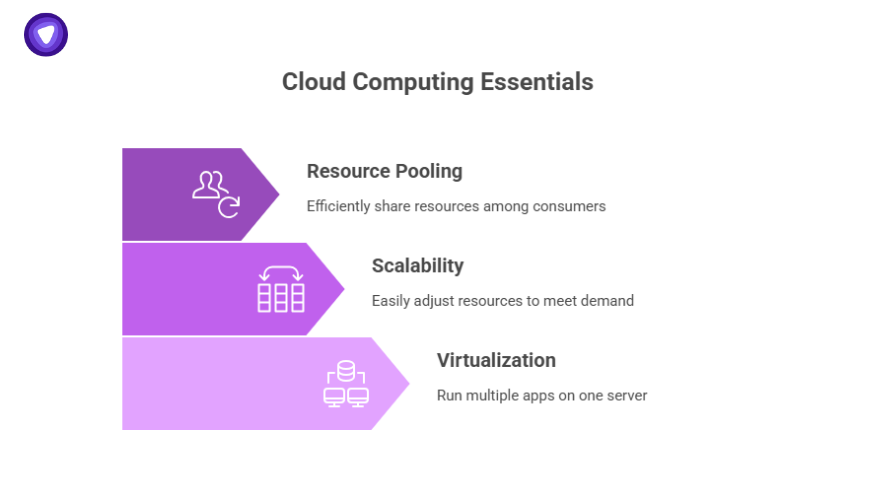
Cloud Computing Essentials Unlock Benefits by offering businesses the tools to understand and implement effective cloud strategies. These essentials include understanding the infrastructure, platforms, and services that make up cloud computing. In simple terms, cloud computing allows enterprises to retrieve data and apps through the Internet. Instead of using local servers or personal computers.
Cloud computing fundamentals cover core services which are, among others, Infrastructure as a Service, Platform as a Service, and Software as a Service. Put briefly, the services give business enterprises the required computing, storage, and application software without necessarily having to invest in expensive physical hardware.
Key computing essentials of the cloud include:
- Virtualization: It complements the virtualization of computers and operating systems with a move to run multiple applications and workloads on one physical server.
- Scalability: With cloud computing, scaling up or down to meet the demand of the business is quite possible. This means if the demand on the business is high, adding resources upward becomes quite easy.
- Resource Pooling: Providers pool resources to serve many consumers. This ensures efficient utilization of resources.
Types of Cloud Computing Essentials

Exploring the different types of Cloud Computing Essentials Unlock Benefits for businesses by helping them choose the right solution tailored to their needs.
Public Cloud
A public cloud is a cloud infrastructure shared between numerous customers, usually provided by companies such as Amazon Web Services, Microsoft Azure, and Google Cloud. Public cloud computing resources are available to companies on a pay-as-you-go basis, which makes scalability cheaper for small to medium enterprises who are the target. The major advantages of a public cloud are the very low maintenance responsibilities for the business and high scalability. Public clouds are otherwise inferior because they do not offer as much control over the security of your data and possibly shared server resources for organizations dealing with sensitive information.
Private Cloud
A private cloud is an environment of the cloud dedicated exclusively to one business, whereby control over data and security are much tighter. The hosting is normally done on the company premises or with a dedicated hosting provider. Private Cloud is thus an infrastructure that, through its customizable resources, meets every business need, and whose level of safety is higher.
Hybrid Cloud
A hybrid cloud model would include both public and private cloud elements. This can enable enterprises to store sensitive data in the private cloud while tapping into a public cloud for scalability and cost-efficiency on less critical operations. Hybrid clouds are flexible, offering a good balance between cost and security; therefore, they are recommended for companies that need scalability of resources with rigid protection of sensitive data. However, the management of a hybrid cloud is a little problematic and demands special caution in the course of integration between the public and private cloud segments for seamless functionality.
Understanding these types of cloud models helps businesses choose the right solution tailored to their operations and ensures they can leverage essential cloud effectively for optimized performance and scalability.
Pros and Cons of Cloud Computing for Businesses
Understanding how Cloud Computing Essentials Unlock Benefits can help businesses weigh the pros and cons effectively.
Pros of Cloud Computing
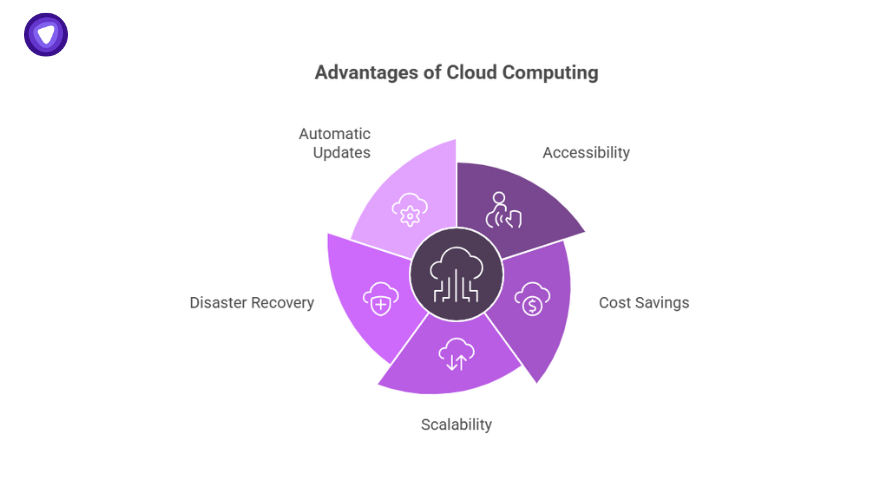
Accessibility
Cloud computing allows employees to access data and applications from anywhere, which is indeed a prerequisite for working remotely or even globally.
Cost Savings
Cost reduction is one of the main advantages of cloud computing. Businesses don’t need to invest in costly hardware or spend on maintenance. Instead, they can pay for what they use.
Scalability
Businesses can easily scale their cloud resources up or down based on current needs. This flexibility is ideal for companies experiencing seasonal or rapid growth.
Disaster Recovery
Cloud computing provides facility choices like backup and recovery options to ensure businesses are able to get back on their feet in case of incidents involving data loss without facing major disruptions.
Automatic Updates
Generally, cloud providers perform updates, and companies do not have to handle any software or security updates themselves.
Cons of Cloud Computing
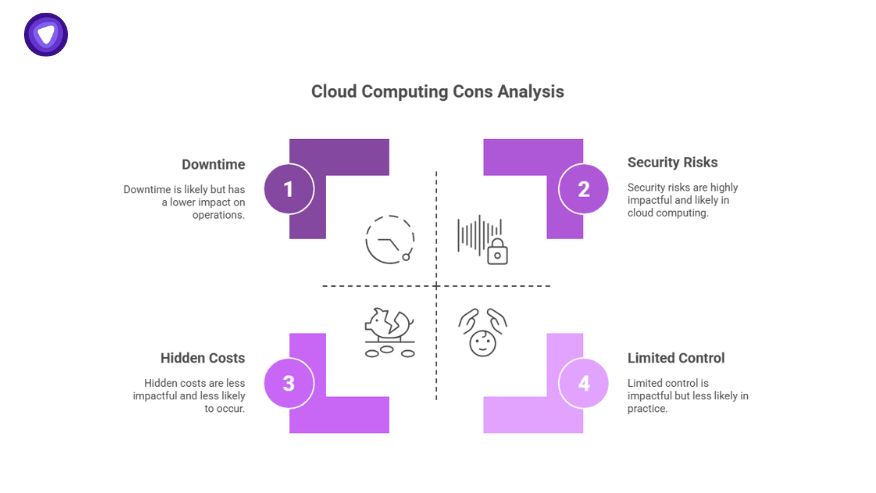
Downtime
It depends on the availability of internet access. If there is an error in the network, there will be disruption in access to data and applications.
Security Risks
Although cloud providers implement Draconian security, leakage of data or unauthorized access might still prevail.
Limited Control
This can be a lack of leeway in applying controls to infrastructure and services, which have to balance strict compliance requirements in many enterprises.
Hidden Costs
While cloud computing is generally cost-effective, additional expenses for data transfers or specialized services can increase.
By weighing these pros and cons, businesses can make informed decisions on how to incorporate cloud computing essentials into their operations.
What Are the 5 Essentials of Cloud Computing?
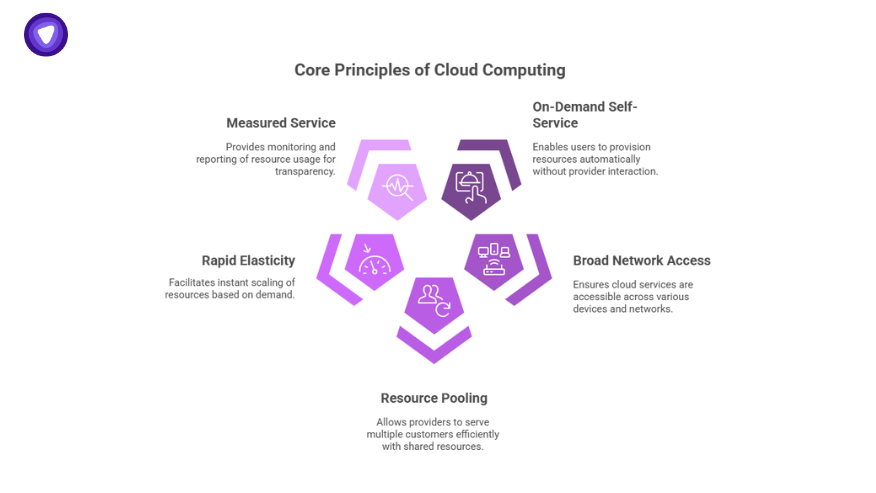
Cloud computing essentials are the core principles that enable cloud services to deliver on their promises—agility, scalability, and cost efficiency. Understanding these five essentials helps businesses unlock the full benefits of cloud deployment:
1. On-Demand Self-Service
Users can provision computing resources—like storage, servers, or apps—automatically, without requiring human interaction with the service provider.
2. Broad Network Access
Cloud services are available over the internet or private networks and are accessible across a wide range of devices, including phones, tablets, laptops, and edge sensors.
3. Resource Pooling
Providers use multi-tenant models to serve many customers with dynamically assigned resources. Clients share infrastructure securely while maintaining data isolation.
4. Rapid Elasticity
Cloud environments can scale up or down instantly based on demand. This is crucial for handling traffic spikes or running AI workloads without overprovisioning.
5. Measured Service
Resource usage is monitored, controlled, and reported, ensuring transparency, efficiency, and cost predictability.
These five essentials are the building blocks of any successful cloud strategy—and the reason cloud computing essentials unlock benefits that traditional IT environments simply can’t match.
Cloud Deployment Checklist: Essentials for Long-Term ROI
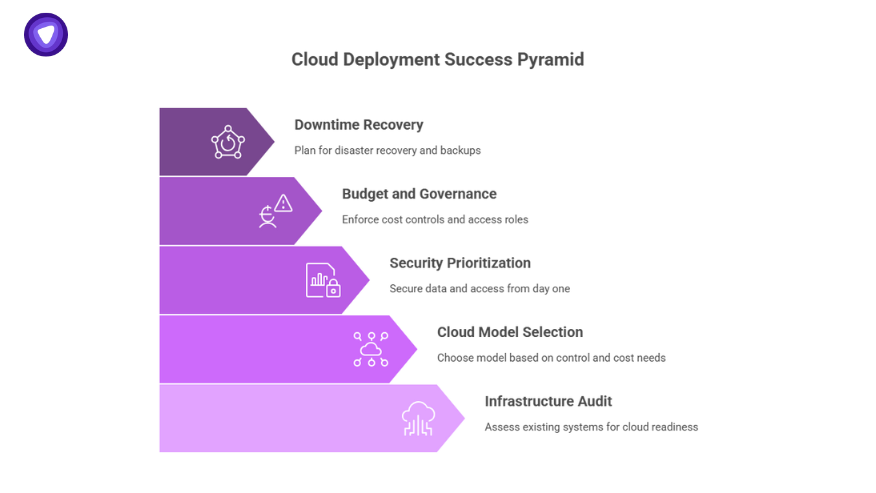
You’ve chosen cloud. That’s step one. But rushing in without a proper plan often leads to wasted budgets, security issues, and performance drops. Here’s a practical checklist to keep your deployment efficient, scalable, and secure.
1. Audit Your Existing Infrastructure
Before you move anything, understand what you already have. Which workloads are cloud-ready? Which are tightly coupled to legacy hardware?
- List all current apps, databases, and storage
- Identify apps with high latency sensitivity or compliance restrictions
- Group workloads into three: move now, rework first, or keep on-prem
2. Choose the Right Cloud Model
SaaS? PaaS? IaaS? Don’t choose based on trend—choose based on control, cost, and security needs.
| Cloud Model | Best For | Key Benefit |
|---|---|---|
| SaaS | Productivity apps, CRM | Easy to deploy, no management needed |
| PaaS | Dev teams building apps | Focus on code, not servers |
| IaaS | Full control | Customization and granular security |
SaaS will lead in 2025 with $390.5B in revenue, but IaaS is the fastest-growing (CAGR of 26.2%).
3. Prioritize Security from Day One
Cloud doesn’t mean secure by default. You need to secure workloads across:
- Data in transit and at rest
- User access controls
- API communications
- Cloud-native threats like misconfigured buckets or container escape
Tip: Use a white label VPN to offer encrypted access to client systems without rebuilding the wheel. PureVPN’s solution gives your clients security under your brand.
4. Set a Cloud Budget and Enforce Governance
Don’t be one of the 78% of organizations scrambling to optimize cloud costs in 2025. Build controls into your architecture from day one:
- Use cost allocation tags across services
- Monitor cloud spend monthly
- Enforce access roles—no blanket admin rights
5. Plan for Downtime and Recovery
Disaster recovery isn’t optional. Even 10 minutes of downtime can mean thousands in losses.
- Set RPO/RTO for each critical workload
- Backup across cloud regions
- Create test recovery drills every quarter
94% of businesses reported improved security after cloud migration, and 91% found compliance easier—but only if planned right.
What Are the Benefits of Cloud Computing for Business?
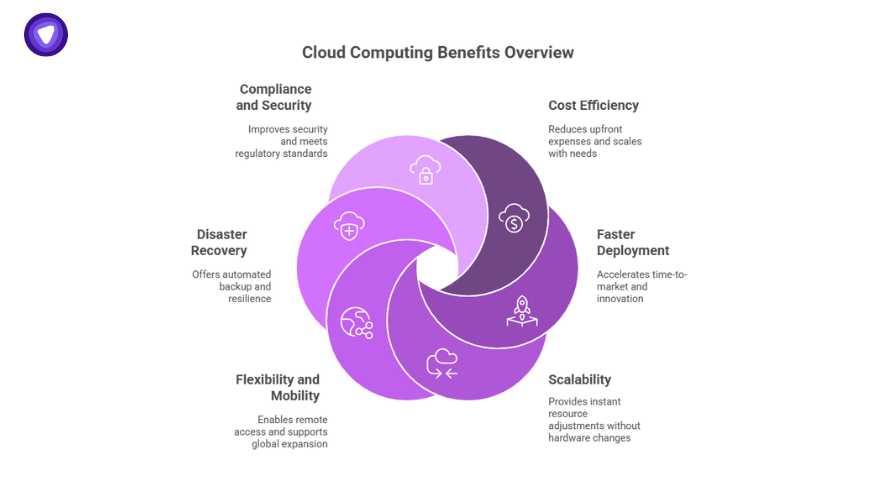
Cloud computing is more than a shift in IT infrastructure—it’s a strategic asset. Businesses of all sizes are adopting cloud platforms not just to store data, but to compete smarter, faster, and leaner.
Here are the key benefits:
1. Cost Efficiency
With cloud computing, you pay only for what you use. No upfront capital expenses, no idle infrastructure. This is especially valuable for startups and SMBs with limited IT budgets. As of 2025, 54% of SMBs spend over $1.2 million annually on cloud—because it scales smartly with their needs.
2. Faster Deployment
Companies can launch new environments or applications in hours, not weeks. 65% of businesses say cloud has helped them reduce time-to-market, accelerating product cycles and innovation.
3. Scalability
Need more power? More users? More storage? Cloud services scale instantly without hardware changes. This elasticity supports rapid growth and peak loads without bottlenecks.
4. Flexibility and Mobility
Cloud enables remote access to systems from anywhere. Whether it’s a hybrid team or global expansion, cloud empowers workforce mobility. This flexibility is key in today’s work-from-anywhere culture.
5. Built-In Disaster Recovery
Outages, breaches, and ransomware can cost millions. Cloud platforms offer automated backup, redundancy, and geographic failover. Even smaller firms now get enterprise-grade resilience.
6. Compliance and Security
94% of businesses report improved security after cloud migration. Cloud providers are often ahead on compliance, helping clients meet standards like GDPR, HIPAA, and SOC 2 with ease.
When you put it all together, it’s clear why cloud computing essentials unlock benefits that are both immediate and long-term, cutting costs while increasing business agility and security.
What Are the Security Benefits of Cloud Computing?
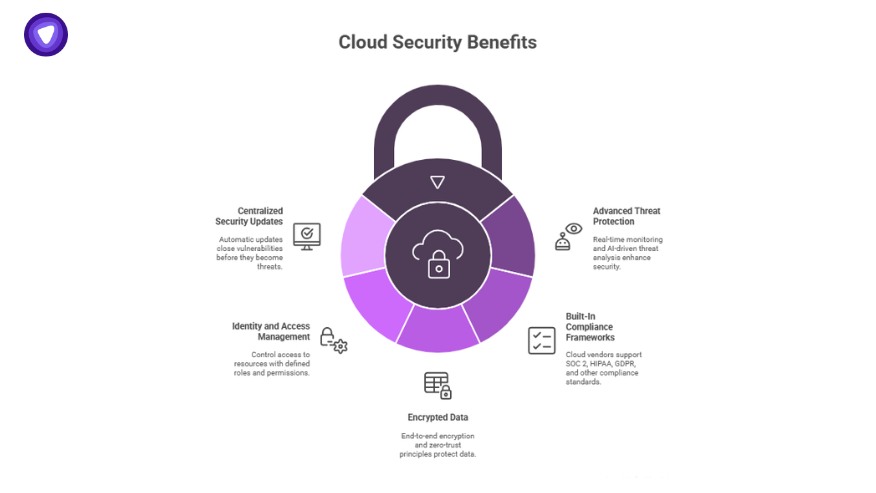
Security is often the number one concern when businesses consider the cloud. Ironically, it’s also one of the biggest reasons they adopt it. Why? Because the right cloud setup can be more secure than on-prem systems.
Here’s what makes cloud security such a strong value proposition in 2025:
1. Advanced Threat Protection
Top cloud providers offer real-time monitoring, intrusion detection, and AI-driven threat analysis. These are tools most small or mid-sized businesses could never afford to build themselves. The result? Faster detection and better prevention of cyberattacks.
2. Built-In Compliance Frameworks
Compliance isn’t just about ticking boxes anymore—it’s about survival. Cloud vendors often build in support for SOC 2, HIPAA, GDPR, and other frameworks. According to RapidScale, 91% of companies say the cloud makes it easier to meet compliance requirements.
3. Encrypted Data at Rest and in Transit
Most providers use end-to-end encryption, zero-trust principles, and strict access control to prevent data leaks or tampering. This is a core part of how cloud computing essentials unlock benefits across security-sensitive industries like finance and healthcare.
4. Identity and Access Management (IAM)
Cloud platforms allow you to define roles, permissions, and device policies at scale. You can control who gets access to what, down to a single folder or app.
5. Centralized Security Updates
Unlike on-prem infrastructure, which often relies on manual patching, cloud providers roll out updates automatically. This closes known vulnerabilities before they become real threats.
Bottom line: Moving to the cloud is not a security risk—it’s a security upgrade. When implemented correctly, cloud computing helps businesses protect data, manage risk, and stay compliant with far less effort.
Applications of Cloud Computing
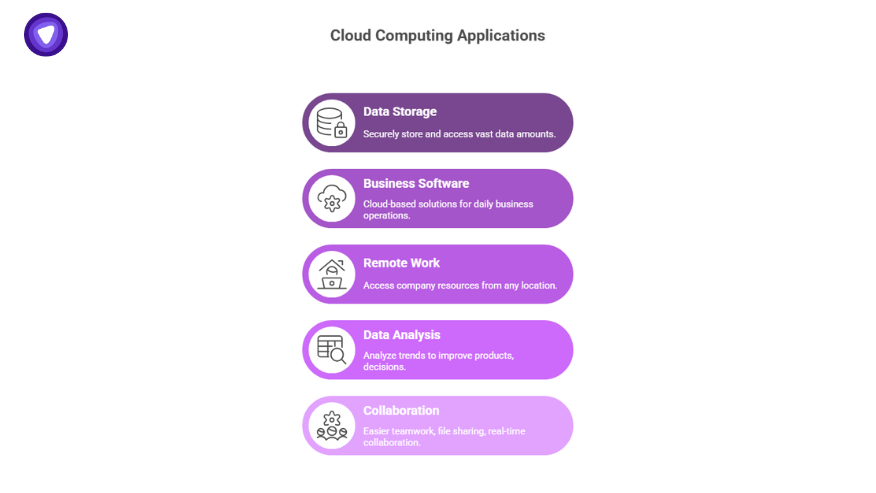
Cloud Computing Essentials Unlock Benefits across different industries, enabling efficient data storage, better software access, and enhanced collaboration
Data Storage and Management
Companies use the cloud to store vast amounts of data securely and access it as needed. This is particularly useful for businesses that handle large files or need to store customer information.
Business Software
Many organizations rely on cloud-based software solutions for daily operations, such as Customer Relationship Management (CRM) tools, project management software, and productivity apps.
Remote Work
Cloud computing supports remote work by allowing employees to access company resources from any location. This has become increasingly important with the rise of hybrid work models.
Data Analysis
Advanced cloud computing essentials include data processing and analytics tools. Businesses use these to analyze customer trends, improve products, and make better decisions.
Collaboration
Cloud platforms make it easier for teams to work together, share files, and collaborate in real time. This is vital for projects that require input from multiple team members or departments.
Business Strategies for Cloud Migration
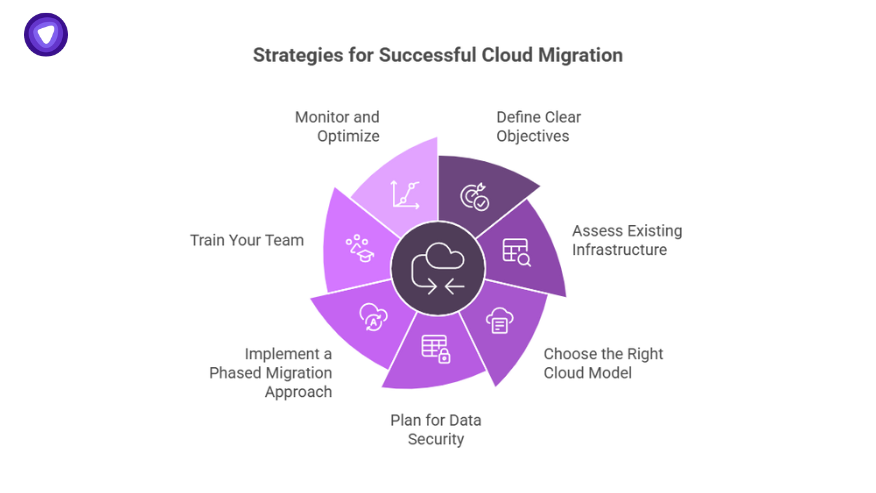
Implementing the right strategies ensures that Cloud Computing Essentials Unlock Benefits throughout the migration process and beyond. Here’s a look at effective business strategies for cloud migration:
Define Clear Objectives
Before migrating, businesses should outline their objectives for moving to the cloud. This could involve cost savings, increased scalability, better data management, or improved accessibility. Defining these goals helps in selecting the right cloud model—be it public, private, or hybrid that aligns with the business’s needs.
Assess Existing Infrastructure
Perform a comprehensive assessment of the existing IT infrastructure, identifying components that are suitable for migration to the cloud and those that might need enhancements or replacement. In this way, the transition will flow seamlessly, with no surprises arising during the migration process. For instance, there could be legacy applications that require adjustments or need to be substituted with their cloud-native counterparts.
Choose the Right Cloud Model
Business success can depend on choosing the right type of cloud setup. Companies can pick between using a public cloud, a private cloud, or a hybrid cloud. A public cloud is a good choice for businesses that need a scalable and affordable solution. If a company deals with sensitive data, it’s better to use a private cloud or a hybrid cloud.
Plan for Data Security
One of the primary concerns in cloud migration is security. Attention should be given to security protocols and practices, which include data encryption, access control, and yearly security audits. Collaboration with cloud providers who execute industry compliance standards like SOC 2 is, among other things, important in ensuring security that will keep the data secure.
Implement a Phased Migration Approach
A phased migration will prevent much disruption but will also allow businesses to overcome the challenges early on. Begin the process of migration of non-critical applications and data to the cloud. When successful, gradually migrate more critical operations to the cloud.
Train Your Team
Educating employees about cloud computing and how to use new tools is an important step in cloud migration. Training ensures that everyone can leverage cloud resources effectively and follow best practices for security and data management.
Monitor and Optimize
The businesses should, from time to time, monitor the post-cloud migration environment. The key minimum requirement for cloud computing involves tools that will enable resource monitoring and performance optimization. Monitoring of different performance metrics enables a business access to facilities needed to make changes and adjust their operations hence assuring efficiency in terms of cost management.
Cloud-Native Security vs. VPN-Based Protection: What Works for Your Clients?
Security remains the #1 concern for most businesses moving to the cloud—and for good reason. The more systems that live online, the more entry points exist for attackers. But not every business needs to build a fortress from scratch. Let’s break down two core options you can offer as a white label service provider.
1. Cloud-Native Security Tools
These are tools built into major cloud platforms—AWS GuardDuty, Azure Defender, GCP Security Command Center. They’re powerful but:
- Require technical expertise to configure correctly
- Are often siloed across platforms
- Come with platform lock-in
If your client’s entire infrastructure sits in AWS, native tools may suffice. But for hybrid or multi-cloud setups, coverage becomes inconsistent.
Pros:
- Deep integration with specific cloud environments
- Real-time alerts and automation
- Good for DevOps-heavy businesses
Cons:
- Not portable
- Steep learning curve
- Harder to resell under your brand
2. VPN-Based and Perimeter Protection (White Label VPN)
A white label VPN like PureVPN’s solution offers a brandable, secure tunnel between your clients and their cloud infrastructure. It’s simple, scalable, and works across any cloud, app, or region.
Pros:
- Fully brandable: Your logo, your pricing, your UI
- Works across various platforms, including AWS, Azure, and on-premises.
- Protects remote teams, SaaS tools, and data transfers
- Requires no heavy technical deployment from your clients
Cons:
- Doesn’t replace deeper security monitoring tools
- Best used in conjunction with endpoint protection and backups
Best For: MSPs, SaaS providers, agencies, and businesses that want to offer core security without building it.
Pairing PureVPN White Label with your cloud solution gives you a recurring revenue stream with zero development cost, plus peace of mind for your clients.
How VPNs Complement Cloud Computing?
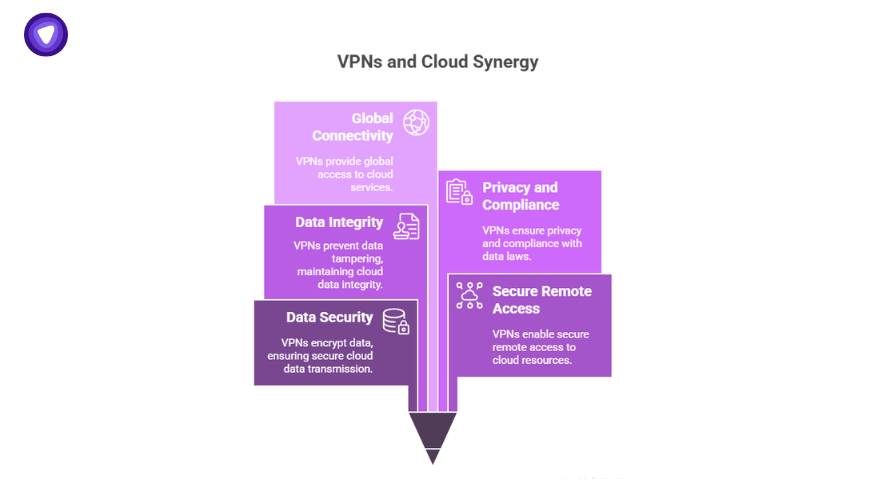
Integrating VPNs with Cloud Computing Essentials Unlock Benefits by adding a vital layer of security and flexibility. A VPN provides a secure and encrypted connection between a user’s device and the internet, making it an ideal companion for cloud computing. Here’s how VPNs complement cloud solutions:
Enhanced Data Security
Data security is a major concern when using cloud services, especially for businesses handling sensitive information. VPNs help add an extra layer of security by encrypting data transmitted between users and cloud servers. This ensures that even if data is intercepted, it cannot be easily accessed or stolen.
Secure Remote Access
To that effect, businesses should always be in continuous monitoring of the post-migration cloud environment. One of the basic requirements of cloud computing concerns the availability of tools to navigate resource monitoring and performance optimizations. The monitoring of various performance metrics allows changes and adjustments in operations at a business level so as to ensure efficiency in cost management.
Protecting Data Integrity
VPNs help maintain data integrity by preventing data tampering during transmission. This is particularly important for businesses that regularly handle financial transactions or exchange confidential client information.
Privacy and Compliance
Businesses that need to comply with data privacy laws and regulations can benefit from using VPNs. A VPN helps maintain user privacy by masking IP addresses and ensuring that data transmissions are secure. This can be crucial for industries like healthcare and finance, where data protection is not just preferred but mandated by law.
Global Connectivity
With a VPN, employees will be able to bypass geographical restrictions and access cloud data and services from anywhere in the world. It has also proven helpful for multinational companies to ensure that their business is always going to run smoothly without regard for location. In this regard, your business can ensure continuity of access to cloud services with a VPN and ensure that productivity is not compromised.
VPNs are an essential addition to cloud computing essentials as they provide the security and flexibility businesses need to make the most of their cloud solutions.
Scaling a Cloud-Based Business with White Label Tools
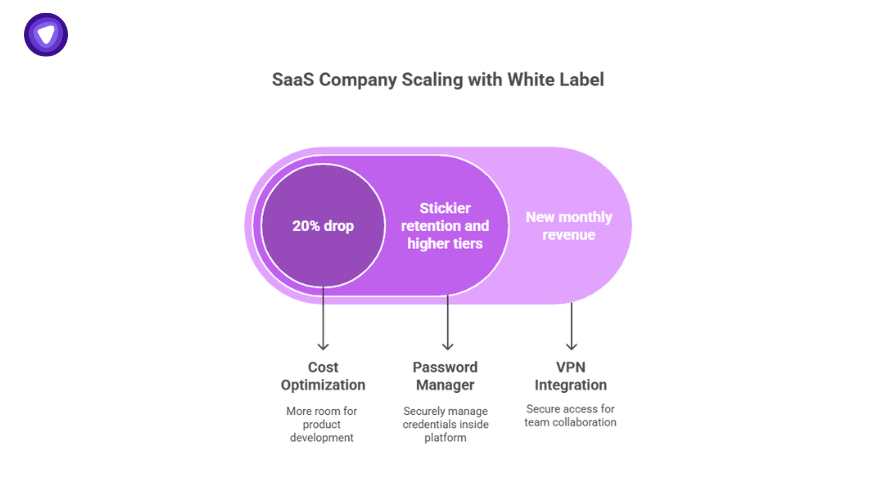
Let’s say you’re running a growing SaaS company that offers project management software to mid-sized businesses. Your product’s backend is hosted on a mix of AWS and Google Cloud. You’ve got two main problems:
- Clients are demanding more security and compliance features.
- You want to increase MRR without expanding your dev team.
Here’s how you could apply cloud computing essentials and unlock real benefits—using white label services.
Step 1: Add a White Label VPN for Access Security
By integrating a white label VPN from PureVPN into your platform, you instantly offer encrypted user access, secure team collaboration, and location masking. There’s no need to build the tech—it’s branded as yours, and you set the pricing.
This helps your clients meet compliance standards (like HIPAA or GDPR) while giving you a new monthly revenue stream per user.
Step 2: Add a White Label Password Manager
Next, layer in a white label password manager—another turnkey product. Clients store, share, and manage credentials securely inside your platform. For your business, this means stickier retention and higher package tiers.
It’s zero development effort for you, but it adds real value for your clients. And you can bundle it with your VPN offer for upselling.
Step 3: Use Cloud Cost Optimization Tools Internally
Internally, you run cost-monitoring software across your hybrid cloud setup. You begin using spot instances on AWS and implement auto-scaling rules. Your infrastructure costs drop 20%, giving you more room for product development.
Why PureVPN White Label Should Power Your Cloud-Centric Business
If your business operates in a cloud-first environment—and most do in 2025—you need a way to deliver security that scales with your customers’ expectations. That’s exactly where PureVPN White Label fits in.
We offer more than just rebranded VPNs. You get a full suite of white label security tools tailored for modern cloud-based businesses.
Here’s what sets us apart:
- Turnkey White Label VPN Platform
Deploy secure, encrypted access for remote teams, SaaS users, or enterprise clients—all under your brand. With global infrastructure and no revenue caps, you’re in full control. - White Label Password Manager
Launch a branded password security solution in under 90 days. Zero development. Zero overhead. Seamless branding. - Scalable API + SDK Integrations
Plug our services directly into your platform or app using documented SDKs. Keep the user experience smooth and branded from end to end. - Compliance-Ready Infrastructure
GDPR. HIPAA. SOC2. We meet the standards so you can promise them. No shortcuts. - Enterprise-Grade Support
You get 24/7 backend support and client-side documentation. We handle the heavy lifting so your team doesn’t have to.
Why This Matters Now?
With over 90% of organizations adopting hybrid or multi-cloud strategies, demand for bundled, easy-to-deploy security tools is skyrocketing. But businesses don’t have the time—or budget—to build these features from scratch. By offering PureVPN’s white label solutions, you step into that gap.
You’re not just adding a new product. You’re building recurring revenue, improving retention, and owning your client experience—without growing your dev team.
Conclusion
Cloud computing has transformed how organizations function, offering unmatched flexibility, scalability, and cost savings. Businesses may place themselves in a position to improve operations, fortify communication, and efficiently arrange data by comprehending cloud computing fundamentals like virtualization, data storage, and application administration. Certain business requirements may be met by choosing the best kind of cloud solution, whether it be private, public, or hybrid. While the pros of cloud computing include reduced costs and improved accessibility, businesses must also consider challenges such as security concerns and hidden costs.


